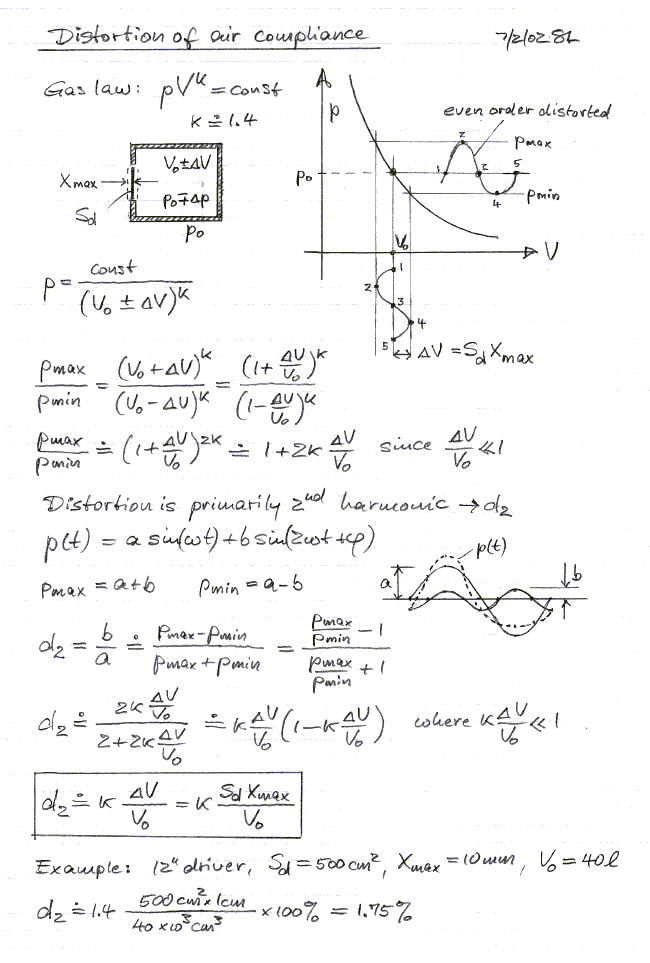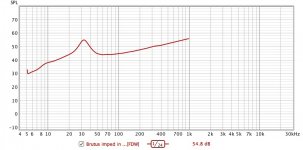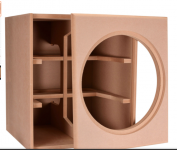Yes, definitely distortion. In my region, 21DS115 would fit in such price range. How about that?
Put it in WinISD. For Qtc .707 it needs 34.46 liters only, Fsc is 94.41 Hz. In the lows it has 2-3 dB less max SPL than Beyma in 100 L.
Make the box 100 liter and then Qtc drops to .476 (high damping), Fsc raises to 61.15 and then it is 2 dB better in the lows than the Beyma. But it's a 21" too, of course.
What exactly makes you write that Beyma would have more distortion in a 100 L box?
Make the box 100 liter and then Qtc drops to .476 (high damping), Fsc raises to 61.15 and then it is 2 dB better in the lows than the Beyma. But it's a 21" too, of course.
What exactly makes you write that Beyma would have more distortion in a 100 L box?
To answer the OP first post please see attached sim of a top quality Pro audio driver in a small (100 litre) sealed box... I doubt any audiophile brand of Hi Fi driver can even come close.
In room performance - 113dB continuous/119dB peak at 20 Hz (!) peak SPL. This assumes plus 6dB room gain for corner placement and a single subwoofer... A pair give you 116dB continuous and 122dB peak...!!
In room performance - 113dB continuous/119dB peak at 20 Hz (!) peak SPL. This assumes plus 6dB room gain for corner placement and a single subwoofer... A pair give you 116dB continuous and 122dB peak...!!
Attachments
Last edited:
PD 2150 bass driver with 6 inch (150mm) voice coil.
PS This is the driver I use in the above Sim.
https://precision-devices.com/wp-content/uploads/2020/09/PD2150-DATASHEET-310114.pdf
PS This is the driver I use in the above Sim.
https://precision-devices.com/wp-content/uploads/2020/09/PD2150-DATASHEET-310114.pdf
A closed box seems to have inherent 2nd harmonic distortion by nature due to the not so linear air spring, and proportional to the ratio of compressed air over box volume. So the smaller the box the higher the distortion.Yes, definitely distortion.
The Linkwitz Closed Box Woofer Design spreadsheet tells me that a 18LEX1600Nd (Xmax=14.5 mm) in a 100 liter box will have a d2 of 2.5 percent at Xmax. In a 50 liter box that would become 5 percent. And if Xmax would then also double then that would become 10 percent.
The formula can be viewed in the spreadsheet and also in Small sealed subs - harmonic distortion -
Techtalk Speaker Building, Audio, Video Discussion Forum by Dennis H.
But 2.5 percent at Xmax doesn't look too bad, does it?
"A closed box seems to have inherent 2nd harmonic distortion by nature due to the not so linear air spring, and proportional to the ratio of compressed air over box volume. So the smaller the box the higher the distortion."
Since the earliest AR speakers - say, 1960 - I've believed the opposite. That is, the "air spring" is more linear under compression than any driver. Which would make sealed boxes cleaner than all other woofer housings. Kind of an Article of Faith, eh.
If you have a link to support your point of view, love to read it if you would please post it.
B.
Since the earliest AR speakers - say, 1960 - I've believed the opposite. That is, the "air spring" is more linear under compression than any driver. Which would make sealed boxes cleaner than all other woofer housings. Kind of an Article of Faith, eh.
If you have a link to support your point of view, love to read it if you would please post it.
B.
Since the earliest AR speakers - say, 1960 - I've believed the opposite. That is, the "air spring" is more linear under compression than any driver. Which would make sealed boxes cleaner than all other woofer housings.
I have also heard this claim, but it contains a flaw - Ben, I invite you to comment on this: The air is being compressed as the cone moves into the box, but is being rarified (expanded) as the cone moves out from the box. Air does not act the same in compression and expansion, and on top of that the spring effect is non-linear. These issues are not so different from those of differences in the suspension compliance in the inward and outward directions. Neither are symmetrical. So using the air-spring of a closed box is not a kind of "solution" for suspension non-linearies, or so it would seem. It's just another source of distortion, typically on the order of a couple of percent at full excursion. It decreases as Vb is much greater than Sd*Xmax, however, this is not the "AR" type of box but rather tending towards infinite baffle.
Siegfried Linkwitz posted a pic of his calculations on this here:

Siegfried also created a spreadsheet called "closed-box1.xls". Part of the information it provides (in response to user input about a driver and the closed box) is the percent distortion that is caused solely by the air-spring itself. Closed-Box1 makes it easy for the user to calculate thsi distortion contribution for a given driver+box combination. Here is a link to the spreadsheet:
SL's closed-box1 Excel spreadsheet
This was developed when he was working on the Thor subwoofer project. The DESIGN section of the project write-up gives some relevant info.
Last edited:
Interesting! How does this relate to the pioneer's 'presumed uniform particle density in a typical box' that to the layman indicates no additional distortion from this air mass 'slug'?
... Air does not act the same in compression and expansion, and on top of that the spring effect is non-linear....
Is that isothermal or adibiatic?*
B.
* I'm not sure what those terms mean but they are supposed to be important.
Isothermic = under same temperature, so when air is compressed it is 'cooled' by some means,
Adiabatic = thermally fully isolated from the environment, and when compressing air then temperature will rise
Adiabatic = thermally fully isolated from the environment, and when compressing air then temperature will rise
Villchur (AR) used to say his speakers were adiabatic. Or maybe it was isothermal.
Surely somebody can clarify how this relates to sealed boxes*. I can't.
B.
*there is a nice paper somewhere on the web that explains it nicely.
Surely somebody can clarify how this relates to sealed boxes*. I can't.
B.
*there is a nice paper somewhere on the web that explains it nicely.
From a physical point of view air compression/expansion in a sealed box cannot be anything else but adiabatic, as any heat exchange with the outside is way too slow with respect to the compression and expansion speed.
So, on compression, air heats up and according to the gas law 'P * V /T = constant' the pressure rises even more. Consequence could be (repeat: could) that distortion is higher than in the isothermic case.
So, on compression, air heats up and according to the gas law 'P * V /T = constant' the pressure rises even more. Consequence could be (repeat: could) that distortion is higher than in the isothermic case.
Hey, and when filling a box with very fine stuff then that stuff can take up heat from the compressing air in milliseconds (the finer grained the better) and act as a cooler. This will bend adiabatic towards isothermic to some degree. So the pressure rise will be less, exactly as if the box was larger ...
Thanks, Andre. Villchur got a patent in 1954 using well-stuffed sealed boxes and isothermal behaviour.
As far as virtual size that you mention, expanded graphene can expand the virtual size of the sealed box almost 50%. Pretty impressive.
https://pubs.acs.org/doi/pdf/10.1021/acsami.9b07965?rand=fexpt29v&
"Closed-box loudspeaker systems (CBLSSs) are compact and simple air-suspension loudspeaker systems, and their low-frequency responses are determined by two fundamental parameters: resonance frequency and total damping. Recently, electronic devices have come to require more compact designs, so the volumes of loudspeaker should be reduced. However, a small loudspeaker cannot retain sufficient acoustic space, resulting in poor low-frequency acoustic performance.
Herein, we investigated acoustic characterization of the CBLSS with different filling materials such as thermally expanded graphene oxide (TEGO), activated carbon, graphene platelets, and melamine foam (MF).
Upon the powder-based test, the resonance frequency of the loudspeaker decreased and resulted in a volume increasing effect inside of the loudspeaker. The TEGO shows almost double volume increase rate, compared to other particle-based filling materials. Employing hybrid filling material that consists of TEGO in an MF cage (TEGO@MF), the volume increase rate of the novel loudspeaker was over 24% at 300 cc.
Because of the high adsorptive characteristics and thermal properties of TEGO, the acoustic performance in the low-frequency domain was clearly enhanced, despite the reduced mass loading. Furthermore, these properties were observed to be highly effective for enhancing the low-frequency acoustic performance of the larger loudspeaker, achieving a volume increase rate of 49.5% in a 700 cc enclosure."
B.
As far as virtual size that you mention, expanded graphene can expand the virtual size of the sealed box almost 50%. Pretty impressive.
https://pubs.acs.org/doi/pdf/10.1021/acsami.9b07965?rand=fexpt29v&
"Closed-box loudspeaker systems (CBLSSs) are compact and simple air-suspension loudspeaker systems, and their low-frequency responses are determined by two fundamental parameters: resonance frequency and total damping. Recently, electronic devices have come to require more compact designs, so the volumes of loudspeaker should be reduced. However, a small loudspeaker cannot retain sufficient acoustic space, resulting in poor low-frequency acoustic performance.
Herein, we investigated acoustic characterization of the CBLSS with different filling materials such as thermally expanded graphene oxide (TEGO), activated carbon, graphene platelets, and melamine foam (MF).
Upon the powder-based test, the resonance frequency of the loudspeaker decreased and resulted in a volume increasing effect inside of the loudspeaker. The TEGO shows almost double volume increase rate, compared to other particle-based filling materials. Employing hybrid filling material that consists of TEGO in an MF cage (TEGO@MF), the volume increase rate of the novel loudspeaker was over 24% at 300 cc.
Because of the high adsorptive characteristics and thermal properties of TEGO, the acoustic performance in the low-frequency domain was clearly enhanced, despite the reduced mass loading. Furthermore, these properties were observed to be highly effective for enhancing the low-frequency acoustic performance of the larger loudspeaker, achieving a volume increase rate of 49.5% in a 700 cc enclosure."
B.
Last edited:
For clarity, I was writing about an empty box, no stuffing, air only.cannot be anything else but adiabatic
1954 was a good year! 😀1954
For two sets of balls with a same total mass the balls with half the diameter will have twice as much total surface. The finer the stuffing (powder is best) the quicker it can heat up or cool down. Or explode instead of burning (grain silo explosions due to the dust).powder-based test
Not good to have true but misleading information - and not good to have endless side discussions going on. So, pending correction by better informed people, here's my summary.A closed box seems to have inherent 2nd harmonic distortion by nature due to the not so linear air spring, and proportional to the ratio of compressed air over box volume. So the smaller the box the higher the distortion.
The Linkwitz Closed Box Woofer Design spreadsheet tells me that a 18LEX1600Nd (Xmax=14.5 mm) in a 100 liter box will have a d2 of 2.5 percent at Xmax. In a 50 liter box that would become 5 percent. And if Xmax would then also double then that would become 10 percent.
...
First of all, you can hardly fit an 18-inch driver into a 100 liter box (3.6 cu ft), let alone a tiny 50 liter box. So that's kind of a straw-man argument.
Given the shortcomings of other housing systems and given that at freq low enough to generate adiabatic air distortion, a woofer might be making 10-20% distortion, not worth fretting about air distortion.
I suppose at higher freq, there isn't enough air compression to have much air distortion.
Simply stuffing a sealed box of adequate size with cheap pillow stuffing may be a good solution.
B.
If you put a Brutus BRZ-15 with Fo of 21 Hz into a semi-stuffed box of 5 cu feet, the Fs goes to 32. Small boxes waste Fs.
(Ignore the scale numbers.)
B.
(Ignore the scale numbers.)
B.
Attachments
Last edited:
First of all, you can hardly fit an 18-inch driver into a 100 liter box (3.6 cu ft), let alone a tiny 50 liter box. So that's kind of a straw-man argument.B.
Then there seems to be a lot of straw men around these days! Some examples:
Denovo Audio Sledge M4-18s Baltic Birch 4.0cuft Subwoofer Flat-Pack for 18" Subwoofers
Denovo Audio Knock-Down MDF 4.0 cu. ft. Subwoofer Cabinet for Dayton Audio 18" Ultimax
So in the DIY world 100 liters for an 18" subwoofer is pretty common, it would seem. YMMV. Also, I don't see too many gigantic commercial home audio subwoofers, either. These days the just use a huge power amp to lift the bass that results from a small-ish but more marketable form factor. So you get the inevitable increase in distortion at higher excursions unless some electronic correction is employed.
Honestly I have to agree with you that bigger is better when it comes to a sealed box. You can use much less amplifier power to get the same output, or put another way the smaller the box the less efficient will be the system at low frequency. You also get more extension and better transient response in a larger box.
"Denovo Audio Knock-Down MDF 4.0 cu. ft. Subwoofer Cabinet for Dayton Audio 18" Ultimax"
Ho, ho, ho..... the driver is mounted mostly on the front surface of that 1.5 inch panel and the box has lots of big ribs. That means it may be true that the interior is 4.0 cu ft, as PE says, but the interior geometry is more generous to the driver than 4 cu ft would otherwise be. (And in terms of home decor, the box is rather bigger than "4.0 cu ft".)
On the other hand, when I was skeptical about stuffing a large driver into 3.5 cu ft, I had i mind a 20 x 20 x 15 inch interior box. Seems tight for an 18-inch driver even if 4.0 can be OK.
For sure, much that is wise in CharlieLaub's post. But as somebody who loves their DSP dearly, my intuition is that there's a big difference in sound quality between a large box (with resonance real low) and a small highly equalized one (with resonance in a badly audible place).
B.
Ho, ho, ho..... the driver is mounted mostly on the front surface of that 1.5 inch panel and the box has lots of big ribs. That means it may be true that the interior is 4.0 cu ft, as PE says, but the interior geometry is more generous to the driver than 4 cu ft would otherwise be. (And in terms of home decor, the box is rather bigger than "4.0 cu ft".)
On the other hand, when I was skeptical about stuffing a large driver into 3.5 cu ft, I had i mind a 20 x 20 x 15 inch interior box. Seems tight for an 18-inch driver even if 4.0 can be OK.
For sure, much that is wise in CharlieLaub's post. But as somebody who loves their DSP dearly, my intuition is that there's a big difference in sound quality between a large box (with resonance real low) and a small highly equalized one (with resonance in a badly audible place).
B.
Attachments
Last edited:
- Home
- Loudspeakers
- Subwoofers
- Are 18", 21" pro audio subwoofers better than 12", 15" hifi subwoofers?

